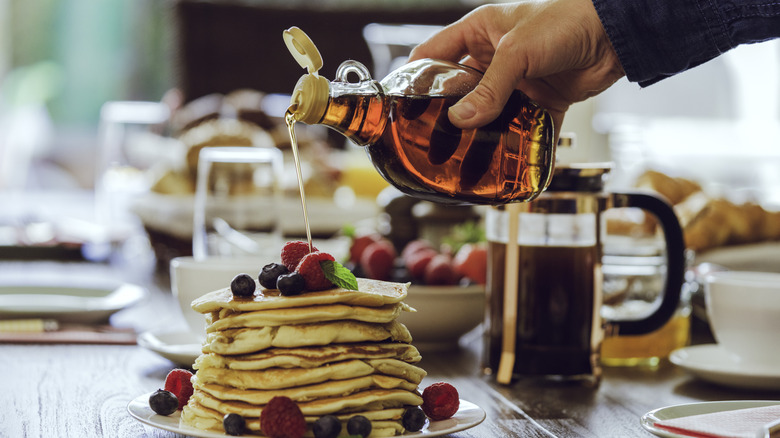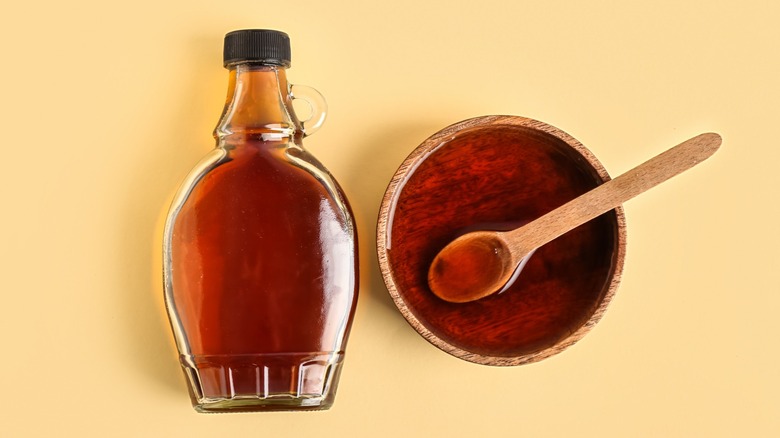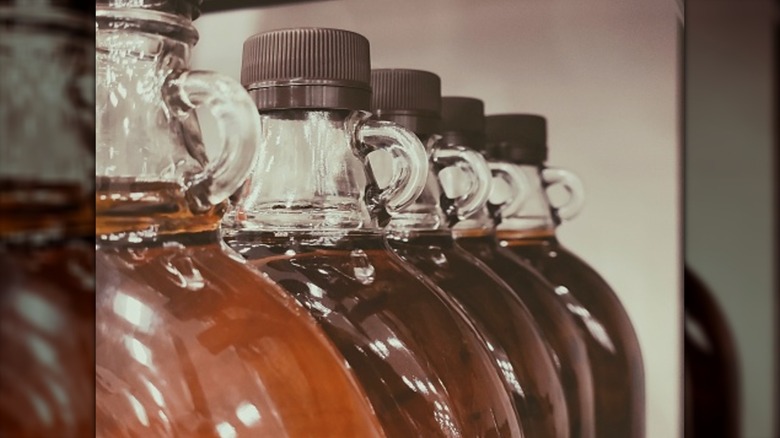The History Of The Maple Syrup Bottle (And Why It Has A Tiny Handle)
Maple syrup is a more recent phenomenon than some people may think. While maple sugar was common for centuries, maple syrup wasn't economical to produce until the turn of the 20th century. At the time, like many mass-produced foods, maple syrup was mostly sold in cans. So what's the deal with the frontier-style bottles with a tiny handle on the neck?
The truth is that these bottles were never meant to be carried by their little handles. They are examples of a skeuomorph, something whose only purpose is to indicate something else. Think of how some vegan meat alternatives appear to bleed when cut: it's irrelevant to the production of Impossible burgers, but it evokes the experience of eating beef.
Similarly, the tiny handle on your maple syrup bottle is only meant to suggest centuries of tradition. The version we know was actually invented after World War II and didn't reach its current form until the 1990s. But the story behind that runs through similar designs as old as the 1920s, and of course a lot of marketing.
The maple syrup bottle finds its form
Perhaps the earliest example of this tiny-handled bottle came in 1922, from Little Brown Jug syrup, a blend that included maple sugar. Appropriately, it was a small, rounded, brown ceramic bottle, with a handle attached to the neck and body. The original design was patented by Joseph Klein, but in 1934 Little Brown Jug modified its bottle to be made of glass, with a circular handle fully contained on a more defined neck.
This new version resembled a 1933 bottle from designer Edwin Fuerst, which featured an angled, almost trapezoidal handle hanging off the neck, and a round body with a rectangular base. Fuerst's design was used by several maple syrup brands in the U.S. and Canada, though it was far from the only container on the market.
In 1951 however, Brooks D. Fuerst — Edwin's younger brother — patented the closest predecessor to today's maple syrup bottles. It was similar to his brother's expired patent, except with a longer body and narrow, scalloped base, similar to the bottle pictured above. This design also saw some pickup with maple syrup brands, but became more popular after Brooks' patent expired in 1965.
How a tiny handle came to mean maple syrup
With the design no longer under patent and embraced by more companies, consumers' identification of the tiny handle with maple syrup began to grow. As the U.S. glassmaking industry collapsed through the 1970s, surviving companies and international competitors still offered versions of the small-handled bottles that syrup brands required. In the 1990s, the squared-off handles gradually modernized into the round handles of today.
These maple syrup bottles adopted their tiny handles to sell a sense of heritage, but now they have a legacy all their own. Ina Garten's favorite maple syrup brand comes in a glass bottle with a small, rounded handle on the neck and body. Even hickory syrup, a smokier alternative to maple, is commonly available in Fuerst-like bottles, likely to associate it with maple syrup.
Today, the maple syrup industry is under threat from climate change, as rising costs strain production. But the tiny-handled bottle remains, as many brands big and small still use various glass bottle designs featuring that distinctive detail.


